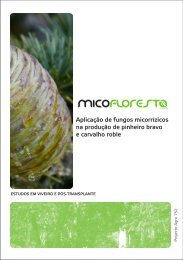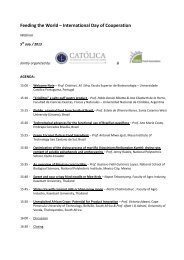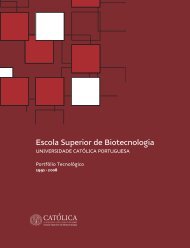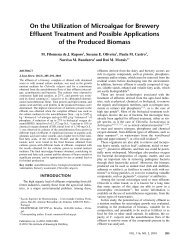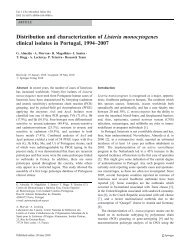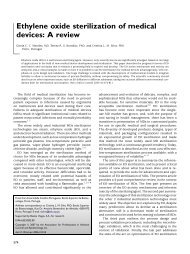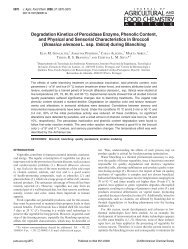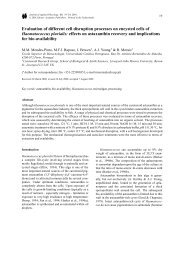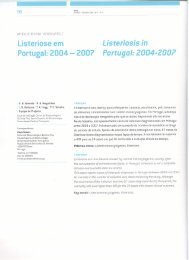Author's personal copy - Escola Superior de Biotecnologia ...
Author's personal copy - Escola Superior de Biotecnologia ...
Author's personal copy - Escola Superior de Biotecnologia ...
You also want an ePaper? Increase the reach of your titles
YUMPU automatically turns print PDFs into web optimized ePapers that Google loves.
Assessment of the plant growth promotion abilities of six bacterial<br />
isolates using Zea mays as indicator plant<br />
Ana P.G.C. Marques a , Carlos Pires a,b , Helena Moreira a , António O.S.S. Rangel a , Paula M.L. Castro a, *<br />
a<br />
<strong>Escola</strong> <strong>Superior</strong> <strong>de</strong> <strong>Biotecnologia</strong>, Universida<strong>de</strong> Católica Portuguesa, Rua Dr. António Bernardino <strong>de</strong> Almeida, 4200-072 Porto, Portugal<br />
b<br />
Cranfield Health, Cranfield University, Building 52A, Cranfield, Bedford MK430AL, England, UK<br />
article info<br />
Article history:<br />
Received 28 January 2010<br />
Received in revised form<br />
12 April 2010<br />
Accepted 19 April 2010<br />
Available online 5 May 2010<br />
Keywords:<br />
PGPR<br />
Zea mays<br />
HCN<br />
Ammonia<br />
IAA<br />
Si<strong>de</strong>rophores<br />
Plant elongation<br />
Plant biomass production<br />
P and N accumulation<br />
1. Introduction<br />
abstract<br />
Plant growth promoting rhizobacteria (PGPR) are a heterogeneous<br />
group of bacteria that can be found in the rhizosphere, at root<br />
surfaces and in association with roots (Ahmad et al., 2008). The<br />
enhancement of crop plant growth using PGPR is documented<br />
(Reed and Glick, 2004) and these organisms have been used to<br />
reduce plant stress associated with phytoremediation strategies for<br />
metal contaminated soils (Reed and Glick, 2005). PGPR enhance<br />
plant growth through various forms, such as: (i) reducing ethylene<br />
production, allowing plants to <strong>de</strong>velop longer roots and better<br />
establish during early stages of growth, due to the synthesis of 1aminocyclopropane-1-carboxylate<br />
(ACC) <strong>de</strong>aminase which modulates<br />
the level of ethylene by hydrolyzing ACC, a precursor of<br />
ethylene, in ammonia and a-ketobutyrate (Glick et al., 1998); (ii)<br />
* Corresponding author. Tel.: þ351 22 558 00 59; fax: þ351 22 509 03 51.<br />
E-mail addresses: amarques@mail.esb.ucp.pt (A.P.G.C. Marques), cmpires@mail.<br />
esb.ucp.pt (C. Pires), helenamoreira@hotmail.com (H. Moreira), aorangel@esb.ucp.pt<br />
(A.O.S.S. Rangel), plcastro@esb.ucp.pt (P.M.L. Castro).<br />
0038-0717/$ e see front matter Ó 2010 Elsevier Ltd. All rights reserved.<br />
doi:10.1016/j.soilbio.2010.04.014<br />
Soil Biology & Biochemistry 42 (2010) 1229e1235<br />
Contents lists available at ScienceDirect<br />
Soil Biology & Biochemistry<br />
journal homepage: www.elsevier.com/locate/soilbio<br />
Zea mays, one of the most important cereals worldwi<strong>de</strong>, is a plant not only with food and energy value,<br />
but also with phytoremediation potential. The use of plant growth promoting (PGP) rhizobacteria may<br />
constitute a biological alternative to increase crop yield and plant resistance to <strong>de</strong>gra<strong>de</strong>d environments.<br />
In search for PGP rhizobacteria strains, 6 bacterial isolates were isolated from a metal contaminated site,<br />
screened in vitro for their PGP characteristics and their effects on the growth of Z. mays were assessed.<br />
Isolates were i<strong>de</strong>ntified as 3A10 T , ECP37 T , corresponding to Chryseobacterium palustre and Chryseobacterium<br />
humi, and 1ZP4, EC15, EC30 and 1C2, corresponding to strains within the genera Sphingobacterium,<br />
Bacillus, Achromobacter, and Ralstonia, respectively. All the bacterial isolates were shown to<br />
produce indole acetic acid, hydrogen cyani<strong>de</strong> and ammonia when tested in vitro for their plant growth<br />
promoting abilities, but only isolates 1C2, 1ZP4 and ECP37 T have shown si<strong>de</strong>rophore production. Their<br />
further application in a greenhouse experiment using Z. mays indicated that plant traits such as root and<br />
shoot elongation and biomass production, and nutrient status, namely N and P levels, were influenced by<br />
the inoculation, with plants inoculated with 1C2 generally outperforming the other treatments. Two<br />
other bacterial isolates, 1ZP4 and ECP37 T also led to increased plant growth in the greenhouse. These 3<br />
species, corresponding to strains within the genera Ralstonia (1C2), Sphingobacterium (1ZP4), and to<br />
a strain i<strong>de</strong>ntified as C. humi (ECP37 T ) can thus be potential agents to increase crop yield in maize plants.<br />
Ó 2010 Elsevier Ltd. All rights reserved.<br />
enhancing asymbiotic nitrogen fixation (Khan, 2005) or indirectly<br />
affecting symbiotic N2 fixation, nodulation or nodule occupancy<br />
(Fuhrmann and Wollum, 1989); (iii) producing or changing the<br />
concentration of plant growth regulators like indole acetic acid<br />
(IAA) (Ahmad et al., 2008); (iv) raising the solubilisation of nutrients<br />
with consequent increase in the supply of bioavailable phosphorous<br />
and other trace elements for plant uptake (Glick, 1995); (v)<br />
production of phytohormones such as auxins, cytokinins and<br />
gibberelins (Glick, 1995); and (vi) synthesis of antibiotic and other<br />
pathogen-<strong>de</strong>pressing substances such as si<strong>de</strong>rophores, cyani<strong>de</strong> and<br />
chelating agents that protect plants from diseases (Kamnev and<br />
Lelie, 2000). These organisms can also increase plant tolerance to<br />
flooding (Grichko and Glick, 2001), salt stress (Mayak et al., 2004a)<br />
and water <strong>de</strong>privation (Mayak et al., 2004b).<br />
Plant growth promoting bacteria are not only significant from an<br />
agricultural point of view, but may also play an important role in<br />
soil remediation strategies, not only by enhancing growth and<br />
successful establishment of plants in polluted soils, but also by<br />
increasing the availability of contaminants, as reported for heavy<br />
metals, namely Zn and Ni, in Thlaspi caerulescens (Whiting et al.,<br />
2001) and in Alyssum murale and Thlaspi goesingense
1230<br />
(Abou-Shanab et al., 2003; Idris et al., 2004). Zea mays is a plant<br />
with food and energy value (Solomon et al., 2007) and also with<br />
phytoremediation potential (Lin et al., 2008; Meers et al., 2010).<br />
The aim of this work was to assess the effect of plant growth<br />
promoting organisms on the growth of Z. mays. A series of rhizospheric<br />
bacterial species were isolated from a metal contaminated<br />
site and were screened for their plant growth promotion abilities,<br />
assessing IAA, si<strong>de</strong>rophores, hydrogen cyani<strong>de</strong>, ACC-<strong>de</strong>aminase<br />
activity and ammonia production. Selected species were further<br />
inoculated onto Z. mays in or<strong>de</strong>r to evaluate their effect on plant<br />
growth and biomass production, and on P and N assimilation.<br />
2. Material and methods<br />
2.1. Bacteria isolation and characterization<br />
Selected bacterial species were indigenous to a metal contaminated<br />
site. The site has a long history of metal contamination, due<br />
to the industrial activity in the surrounding area. Despite the high<br />
presence of metals e average levels of 835 mg Pb kg 1 ,66mg<br />
Hg kg 1 ,26mgCrkg 1 ,37mgNikg 1 , 16,800 mg Fe kg 1 and<br />
3620 mg Zn kg 1 e the area is prolific in vegetation (Marques et al.,<br />
2007).<br />
Bacterial isolation was performed from sediments collected at<br />
the site. Sediment samples were serially diluted in saline solution<br />
(0.85% (w/v) NaCl) and inoculated on trypticase soy agar (TSA;<br />
Oxoid) adjusted to pH 5, 6 and 7, using buffer solutions at<br />
concentrations of 100 mM at 30 C. Visually different colonies<br />
selected on the basis of colony morphology and color were selected<br />
and were further purified by subculturing and preserved at 80 C<br />
in modified Luria-Bertani broth (MLB) (Tiago et al., 2004), supplemented<br />
with 15% (v/v) glycerol. This sampling yiel<strong>de</strong>d a total of 320<br />
strains. These strains were grown un<strong>de</strong>r heavy metal stress (Zn, Cd<br />
and As). Of these, 6 strains were selected based on their metal<br />
resistance ability as an additional important value for further<br />
applications. Four isolates <strong>de</strong>signated as 1ZP4, EC15, EC30 and 1C2,<br />
and 2 isolates i<strong>de</strong>ntified as ECP37 T and 3A10 T (Pires et al., 2010)<br />
were used. Tests listed below were performed on all strains. The pH<br />
range for growth was <strong>de</strong>termined in buffered trypticase soy broth<br />
(TSB) adjusted at pH 3e10 (at 1 pH unit intervals). The turbidity of<br />
the cultures grown in an orbital shaker at 25 C was measured at<br />
610 nm. All buffer solutions used to adjust the pH of TSB were<br />
prepared from 1 M stock solutions according to Gomori (1990).<br />
Citrate buffer was used for pH 3e6, phosphate buffer for pH 7, Tris<br />
buffer for pH 8, and a carbonate-bicarbonate buffer for pH 9 and 10.<br />
Growth temperature ranges were <strong>de</strong>termined on TSA incubated at<br />
4, 10, 15, 20, 25, 30, 37 and 50 C. Extraction of genomic DNA, PCR<br />
amplification of the 16S rRNA gene and sequencing of the purified<br />
PCR products were carried out as <strong>de</strong>scribed by Rainey et al. (1996).<br />
Cloning of the amplicons into pGEM T-Easy vector (Promega) and<br />
cycle-sequencing were performed at Macrogen Inc. (Seoul,<br />
Republic of Korea), using 16S universal bacterial primers (f27, f518,<br />
r800, r1492) (Lane, 1991). The quality of the 16S rRNA gene<br />
sequences was checked manually by the use of BioEdit program<br />
(version 7.0.5.3) (Hall, 1999), and the sequences were aligned<br />
against representative reference sequences of the most closely<br />
related members obtained from the National Center for Biotechnology<br />
Information database.<br />
2.2. Assays for <strong>de</strong>tection of plant growth promoting ability<br />
IAA production by the bacterial isolates was measured by the<br />
method of Wohler (1997). The bacteria were grown overnight on<br />
nutrient broth and then collected by centrifugation at 7000 g for<br />
5 min. The bacterial pellet was incubated at 37 C for 24 h with 3 ml<br />
A.P.G.C. Marques et al. / Soil Biology & Biochemistry 42 (2010) 1229e1235<br />
of phosphate buffer (pH 7.5) with glucose (1%) and tryptophan (1%).<br />
After incubation, 2 ml of 5% trichloroacetic acid and 1 ml of 0.5 M<br />
CaCl2 were ad<strong>de</strong>d. The solution was filtered (Whatman No. 2 of pore<br />
size) and to 3 ml of the filtrate 2 ml of salper solution (2 ml 0.5 M<br />
FeCl3 and 98 ml 35% perchloric acid) were ad<strong>de</strong>d. This mixture was<br />
incubated for 30 min at 25 C in the dark. The absorbance of the<br />
resulting solution was measured at 535 nm with a Shimadzu UV-<br />
1603 spectrophotometer.<br />
For assessing the ability to produce NH3, fresh cultures were<br />
inoculated into 10 ml peptone water and incubated for 48e72 h at<br />
30 C; following this, 0.5 ml of Nessler’s reagent were ad<strong>de</strong>d to each<br />
tube and <strong>de</strong>velopment of yellow to brown color was consi<strong>de</strong>red as<br />
a positive result for ammonia production (Cappuccino and<br />
Sherman, 1992). The screening of hydrogen cyani<strong>de</strong> production<br />
by the bacterial isolates was ma<strong>de</strong> by amending nutrient agar with<br />
4.4 g glycine/l and streaking the isolates on this modified agar<br />
plates; a Whatman no.1 filter paper soaked in a 2% sodium<br />
carbonate in 0.5% picric acid solution was placed on top of each<br />
plate and plates were sealed and incubated at 30 C for 4 d after<br />
which <strong>de</strong>velopment of orange to red color indicated HCN production<br />
by the isolates (Ahmad et al., 2008). Bacterial isolates were<br />
assayed for si<strong>de</strong>rophores production by spot inoculating the<br />
isolates (10 ml of10 6 CFU/ml) on Chrome azurol S agar medium;<br />
<strong>de</strong>velopment of a yellow to orange halo around the bacterial<br />
growth after incubation at 30 C for 48e72 h indicated a positive<br />
result for si<strong>de</strong>rophore production (Schwyn and Neilands, 1987).<br />
ACC-<strong>de</strong>aminase activity was assayed according to a modification<br />
of the method of Honma and Shimomura (1978) which measures<br />
the amount of a-ketobutyrate produced upon the hydrolysis of ACC.<br />
The number of mmol of a-ketobutyrate produced by this reaction<br />
was <strong>de</strong>termined by comparing to a standard curve of a-ketobutyrate<br />
ranging between 0.1 and 1 mmol to which 2 ml of 2,4-dinitrophenylhydrazine<br />
(0.2% 2,4-dinitrophenylhydrazine in 2 mol l 1<br />
HCl) was ad<strong>de</strong>d to each standard, and was then vortexed and<br />
incubated at 30 C for 30 min. Color was <strong>de</strong>veloped by the addition<br />
of 2 ml, 2 mol l 1 NaOH, and the absorbance of the mixture was<br />
measured after mixing by using UNICAM HELIOS Ò spectrophotometer<br />
(Waltham, USA), at 540 nm. For <strong>de</strong>termining ACC-<strong>de</strong>aminase<br />
activity, the bacterial cell pellets were suspen<strong>de</strong>d in 5 ml of<br />
0.1 mol l 1 TriseHCl, pH 7.6, transferred to microcentrifuge tubes<br />
and centrifuged at 16,000 rpm for 5 min; the pellets were suspen<strong>de</strong>d<br />
in 2 ml 0.1 mol l 1 Tris HCl, pH 8.5. Thirty ml of toluene were<br />
ad<strong>de</strong>d to the cell suspension and vortexed for 30 s and 200 ml of the<br />
resulting suspension were placed in a fresh microcentrifuge tube, to<br />
which with 20 ml of 0.5 mol l 1 ACC were ad<strong>de</strong>d; samples were<br />
vortexed, and incubated at 30 C for 15 min. Following the addition<br />
of 1 ml of 0.56 mol l 1 HCl, the mixture was vortexed and centrifuged<br />
for 5 min at 16,000 rpm at room temperature and 2 ml of the<br />
resulting supernatant were vortexed together with 1 ml of<br />
0.56 mol l 1 HCl, after which 2 ml of 2,4-dinitrophenylhydrazine<br />
reagent was ad<strong>de</strong>d, following vortexing and incubation at 30 C for<br />
30 min. Two ml of 2 mol l 1 NaOH were ad<strong>de</strong>d and mixed and the<br />
absorbance of the mixture was read at 540 nm.<br />
For all the above mentioned tests, sterile nutrient broth or agar<br />
were used as a control for bacterial growth.<br />
2.3. Zea mays growth e experimental <strong>de</strong>sign<br />
Z. mays seeds were surface sterilised with 0.5% (v/v) NaOCl for<br />
10 min and were subsequently washed with sterilised <strong>de</strong>ionised<br />
water. Seeds were germinated in plastic pots (8 cm diameter) with<br />
about 300 g sterilised (120 C for 70 min in two consecutive days)<br />
agricultural soil (soil properties are shown in Table 1), in or<strong>de</strong>r to<br />
ensure that possible observed differences in plant traits were<br />
caused only by the applied bacterial treatments. Each pot received
Table 1<br />
Soil properties.<br />
pH 6.44 0.08<br />
Water content (%) 4.84 0.03<br />
Organic content (%) 11.3 0.2<br />
N (mg kg 1 ) 4200 150<br />
P (mg kg 1 ) 260 21<br />
Mn (mg kg 1 ) 39 2<br />
K (mg kg 1 ) 10,600 124<br />
Zn (mg kg 1 ) 33 2<br />
Pb (mg kg 1 ) 8.7 0.3<br />
Cu (mg kg 1 ) 40 2<br />
Cr (mg kg 1 ) 40 6<br />
As (mg kg 1 ) EC30 ¼ EC15 ¼ 1ZP4 (Table 6).<br />
3.2. Plant traits<br />
Fig. 1 shows the effect of the application of different bacterial<br />
isolates in root and shoot elongation of Z. mays. The root elongation<br />
of the plants varied from a minimum of 40 (registered in the control<br />
group) to a maximum value of 55.6 cm (observed in the group of<br />
plants inoculated with EC30), with all the isolates, with the<br />
exception of 1C2, promoting significantly (P < 0.05) root growth<br />
when compared to control non-inoculated plants. Shoot elongation<br />
Table 2<br />
Characteristics of strains 3A10 T , ECP37 T , 1ZP4, EC15, EC30 and 1C2.<br />
Characteristic 3A10 T<br />
ECP37 T<br />
1ZP4 EC15 EC30 1C2<br />
Growth temperature ( C)<br />
Range 10e37 4e37 10e40 15e32 10e40 10e40<br />
Optimum 30 25e30 25e30 25 30 25<br />
pH for growth<br />
Range 6e9 6e9 5e9 6e8 5e9 5e9<br />
Optimum 7 7e8 7 6e7 7e8 6e7
1232<br />
Table 3<br />
Closest relatives (BLAST search) of strains 3A10 T , ECP37 T , 1ZP4, EC15, EC30 and 1C2.<br />
Strain 16S rRNA Class of<br />
fragment<br />
length (bp)<br />
bacteria<br />
Closest<br />
relatives<br />
Similarity<br />
(%)<br />
Accession<br />
number<br />
3A10 T 1249 Flavobacteria Chryseobacterium<br />
palustre<br />
100 EU360967<br />
ECP37 T 1249 Flavobacteria Chryseobacterium<br />
humi<br />
100 EU360967<br />
1ZP4 1417 Sphingobacteria Sphingobacterium<br />
sp. MG2<br />
99 AY556417<br />
EC15 1465 Bacilli Bacillus sp. K22-25 99 EU333888<br />
EC30 1350 b-<br />
Achromobacter 99 FJ827751<br />
proteobacteria sp., EP17<br />
1C2 1450 b-<br />
Ralstonia<br />
98 AM260479<br />
proteobacteria eutropha H16<br />
ranged from a minimum length of 40.2 (observed in one of the<br />
replicates of the control plants) to a maximum of 59 (registered for<br />
plants inoculated with 1ZP4), with all the isolates promoting<br />
significantly (P < 0.05) shoot growth when compared to control<br />
plants; the isolates that better performed were 1ZP4, ECP37 T and<br />
1C2.<br />
The effect of the application of the six bacterial isolates on plant<br />
biomass production is shown in Fig. 2. The root dry biomass of Z.<br />
mays varied from 0.7289 (observed in one of the control plants) to<br />
1.5008 g (registered in a case of plants inoculated with ECP37 T ),<br />
with the isolates 1C2 and ECP37 T promoting significantly (P < 0.05)<br />
root biomass production when compared to control non-inoculated<br />
plants e the treatments with the remaining isolates did not show<br />
any significant effect (P < 0.005) in comparison with control plants.<br />
For the shoot, the biomass ranged from 0.6214 (for a control plant)<br />
to 2.8424 g (for a plant replicate of the treatment with 3A10 T ), with<br />
all the isolates promoting significantly (P < 0.05) shoot growth<br />
when compared to control plants; the isolates that better performed<br />
were 3A10 T , ECP37 T and 1C2.<br />
The levels of P in Z. mays roots and shoots are registered in<br />
Fig. 3A. Phosphorous levels in the roots ranged from 404 (registered<br />
in the control treatment) to 1139 mg kg 1 (observed in for a plant<br />
inoculated with 1C2), with the isolates 1C2 and 1ZP4 promoting<br />
significantly (P < 0.05) root P accumulation when compared to<br />
control non-inoculated plants e the treatment with the 1C2 isolate<br />
significantly (P < 0.05) outperformed the remaining ones, followed<br />
by the treatment with 1ZP4. In the case of the shoot, the P levels<br />
ranged from 251 (in control) to 802 mg kg 1 (in the treatment with<br />
1C2), with the isolates 1C2, EC15, 3A10 T and EC30 promoting<br />
significantly (P < 0.05) shoot accumulation of P when compared to<br />
control plants; the isolate that most significantly (P < 0.05)<br />
increased P accumulation was, as for root tissues, 1C2.<br />
Table 4<br />
Indole acetic levels (mg l 1 ) of screened isolates at 48 and 72 h.<br />
Isolate IAA 48 h (mg l 1 ) IAA 72 h (mg l 1 )<br />
1C2 14 3 a<br />
15 3 a<br />
3A10 5 1 bc<br />
5 1 b<br />
EC30 2,9 0,6 c<br />
4 1 b<br />
1ZP4 7 4 b<br />
6 3 b<br />
EC15 3,1 0,5 c<br />
5 1 b<br />
ECP37 3 1 c<br />
5,0 0,3 b<br />
F5,18 ¼ 36,260 (P < 0.001) F5,18 ¼ 15,079 (P < 0.001)<br />
Results are expressed as means SD (n ¼ 4). One way ANOVA was performed for<br />
each time. Means for the same time with different letters are significantly different<br />
from each other (P < 0.05) according to the Duncan test. IAA was never <strong>de</strong>tected in<br />
control cultures which were thus not consi<strong>de</strong>red for this statistical analysis.<br />
A.P.G.C. Marques et al. / Soil Biology & Biochemistry 42 (2010) 1229e1235<br />
Table 5<br />
In vitro screening results for cyani<strong>de</strong>, ammonia and si<strong>de</strong>rophore production.<br />
Isolate HCN production NH3 production Si<strong>de</strong>rophore production<br />
Control ND ND ND<br />
1C2 þ þ þ<br />
3A10 þ þ ND<br />
EC30 þ þ ND<br />
1ZP4 þ þ þ<br />
EC15 þ þ ND<br />
ECP37 þ þ þ<br />
ND e No color <strong>de</strong>velopment <strong>de</strong>tected; þ e positive color <strong>de</strong>velopment (n ¼ 4).<br />
Fig. 3B represents the levels of N in Z. mays roots and shoots.<br />
Nitrogen levels ranged from 678 (registered in the control plants<br />
group) to 1750 mg kg 1 (observed in a replicate of the group of<br />
plants inoculated with 1C2), with the isolates 1C2, EC30 and ECP37 T<br />
promoting significantly (P < 0.05) root N accumulation when<br />
compared to control non-inoculated plants. In the case of the shoot,<br />
the N levels ranged from 461 (in the control) to 1609 mg kg 1 (for<br />
a replicate in the 1C2 treated plants), with all the treatments<br />
promoting significantly (P < 0.05) shoot accumulation of N when<br />
compared to control plants; the isolate that significantly (P < 0.05)<br />
better performed was 1C2, as for P accumulation.<br />
3.3. Interactions between plant parameters and bacterial traits<br />
In the present study, IAA levels shown by the isolates at 72 h<br />
were generally positively related (P < 0.05) with all plant traits<br />
(Table 7). The relation between si<strong>de</strong>rophores, ammonia and HCN<br />
production and plant traits is also shown by the Spearman correlation<br />
coefficients presented in Table 7 The production of si<strong>de</strong>rophores<br />
shown by the isolates was always positively related<br />
(P < 0.05) with nitrogen accumulation and biomass of the plant<br />
tissues; ammonia and hydrogen cyani<strong>de</strong> production by the isolates<br />
was also positively and significantly (P < 0.05) related to some plant<br />
characteristics such as elongation of roots (Spearman coefficients of<br />
0.487 for both ammonia and HCN production) and shoots<br />
(Spearman coefficients of 0.595 for both bacterial traits) observed<br />
in the greenhouse experiment (Table 7).<br />
4. Discussion<br />
Plant rhizosphere is a preferential niche for various types of<br />
microorganisms in the soil. In the present investigation, 6 bacterial<br />
isolates were screened in vitro for their plant growth promoting<br />
(PGP) abilities. The isolates, named as 1ZP4, EC15, EC30, ECP37 T ,<br />
3A10 T and 1C2 were i<strong>de</strong>ntified as Sphingobacterium sp., Bacillus sp.,<br />
Achromobacter sp., C. humi, C. palustre and Ralstonia eutropha.<br />
Rhizosphere species referred to promote corn growth inclu<strong>de</strong><br />
Table 6<br />
ACC-<strong>de</strong>aminase activity (nmol a-ketobutyrate g 1 h 1 ) of screened isolates.<br />
Isolate ACC-<strong>de</strong>aminase activity<br />
1C2 6 4 c<br />
3A10 19 9 b<br />
EC30 n.d.<br />
1ZP4 n.d.<br />
EC15 n.d.<br />
ECP37 57 15 a<br />
F5,18 ¼ 36,260 (P < 0.001)<br />
Results are expressed as means SD (n ¼ 4). Means with different letters are<br />
significantly different from each other (P < 0.05) according to the Duncan test. ACC<strong>de</strong>aminase<br />
activity was never <strong>de</strong>tected in control cultures which were thus not<br />
consi<strong>de</strong>red for this statistical analysis; n.d. means no activity was found.
Fig. 1. Root and shoot elongation (cm) of Zea mays. Results are expressed as<br />
means SD (n ¼ 4). One way ANOVA was performed for each plant section. Means for<br />
the same plant section with different letters are significantly different from each other<br />
(P < 0.05) according to the Duncan test. The F-values of ANOVA for root and shoot<br />
lengths are F6,21 ¼ 2.970 (P < 0.05) and F6,21 ¼ 9.287 (P < 0.001), respectively.<br />
Pseudomonas putida (Mehnaz and Lazarovits, 2006), Gluconacetobacter<br />
azotocaptans (Mehnaz and Lazarovits, 2006; Mehnaz et al.,<br />
2006) and several Azospirillum species e namely Azospirillum zeae<br />
(Mehnaz et al., 2007b), Azospirillum cana<strong>de</strong>nse (Mehnaz et al.,<br />
2007a) and Azospirilum lipoferum (Mehnaz and Lazarovits, 2006).<br />
Sphingobacterium species with growth promoting traits, e.g.,<br />
Sphingobacterium cana<strong>de</strong>nse, have also been isolated from corn<br />
roots (Mehnaz et al., 2007c). Different studies have also reported<br />
strains from Bacillus species to be effective in promoting Z. mays<br />
growth, namely Bacillus subtilis (Araujo, 2008), and to protect other<br />
plants from diseases, such as wilt in tomato (Anith et al., 2004).<br />
Inoculation with Chryseobacterium species, e.g., Chryseobacterium<br />
balustinum, has also been shown to enhance Arabidopsis thaliana<br />
plant growth and to protect against disease (Solano et al., 2008).<br />
The same was reported for the Achromobacter genus e a good<br />
example is the reduction of ethylene production and increased<br />
biomass in tomato plants inoculated with an isolate of Achromobacter<br />
piechaudii (Mayak et al., 2004a; Mayak et al., 2004b). In the<br />
case of Ralstonia species, some reports indicate some isolates as<br />
metal resistant (Goris et al., 2001), an ability with significant<br />
importance in plant growth promotion in disturbed environments,<br />
but the genus inclu<strong>de</strong>s an important plant pathogen, Ralstonia<br />
solanacearum (Hayward, 1991).<br />
Plants use phytohormones, such as auxins (e.g., indole acetic<br />
acid) to influence many cellular functions (Glick et al., 1999). All the<br />
isolates used in this study presented IAA production, most of the<br />
isolates generating levels comparable to those presented in other<br />
reports. Ahmad et al. (2008) reported levels of 2.13 and 3.6 mg l 1<br />
for Azotobacter and Pseudomonas species, whereas Gravel et al.<br />
(2007) reported levels of 3.3 and 6.2 mg l 1 for P. putida and Tricho<strong>de</strong>rma<br />
atroviri<strong>de</strong>. However isolate 1C2, a Ralstonia species,<br />
showed much higher IAA production levels. IAA production by the<br />
isolates were positively related with all plant traits, with the<br />
exception of the correlation with root length that was not significant,<br />
probably due to the variable effect of IAA on root elongation. A<br />
low level of IAA produced by rhizobacteria promotes primary root<br />
elongation, whereas a high level increases lateral and adventitious<br />
root formation but inhibits the primary root growth (Xie et al.,<br />
1996). 1C2 treated plants appear as those with the highest root<br />
biomass production, which can be explained by the higher extent of<br />
adventitious roots. Plants inoculated with isolates with higher IAA<br />
production (namely 1C2), presented higher shoot elongation and<br />
A.P.G.C. Marques et al. / Soil Biology & Biochemistry 42 (2010) 1229e1235 1233<br />
Fig. 2. Biomass of roots and shoots of Zea mays. Results are expressed as means SD<br />
(n ¼ 4). One way ANOVA was performed for each plant section. Means for the same<br />
plant section with different letters are significantly different from each other (P < 0.05)<br />
according to the Duncan test. The F-values of ANOVA for root and shoot lengths are<br />
F6,21 ¼ 12.093 (P < 0.001) and F6,21 ¼ 6.422 (P < 0.001), respectively.<br />
also P and N accumulation in their tissues. Exogenous sources of<br />
IAA are responsible for changes in the morphology of the root<br />
system and influence the uptake of nutrients by the plant (San<br />
Francisco et al., 2005). This seemed to play an important role in<br />
Fig. 3. P (A) and N (B) levels in Zea mays roots and shoots. Results are expressed as<br />
means SD (n ¼ 4). One way ANOVA was performed for each plant section and for<br />
each element. Means for the same plant section with different letters are significantly<br />
different from each other (P < 0.05) according to the Duncan test. The F-values of<br />
ANOVA for root and shoot P contents (A) are F6,21 ¼ 20.705 (P < 0.001) and<br />
F6,21 ¼ 30.852 (P < 0.001), respectively. The F-values of ANOVA for root and shoot N<br />
contents (B) are F6,21 ¼ 26.517 (P < 0.001) and F6,21 ¼ 5.193 (P < 0.005), respectively.
1234<br />
Table 7<br />
Spearman’s correlation coefficients between plant and bacterial traits.<br />
Plant traits Bacterial traits<br />
IAA<br />
(48 h)<br />
IAA<br />
(72 h)<br />
Si<strong>de</strong>rophores HCN Ammonia ACC<strong>de</strong>aminase<br />
Shoot elongation 0.517** 0.547** 0.622** 0.595* 0.595** n.s.<br />
Shoot biomass 0.581** 0.679** 0.518** 0.594** 0.594** 0.677**<br />
Shoot P 0.751** 0.564** n.s. 0.505** 0.505** n.s.<br />
Shoot N n.s. 0.436* 0.625** n.s. n.s. n.s.<br />
Root elongation n.s. n.s. n.s. 0.487** 0.487** n.s.<br />
Root biomass 0.383* 0.277* 0.777** n.s. n.s. 0.497**<br />
Root P 0.499** 0.541** 0.616** n.s. n.s. n.s.<br />
Root N 0.519** 0.676** 0.465* 0.606** 0.606** 0.406*<br />
**Correlation is significant at the 0.01 level; * correlation is significant at the 0.05<br />
level; n.s., no significant correlation.<br />
the present study, as P uptake by the plant increased when plants<br />
were treated with some of the isolates, especially 1C2 (Ralstonia<br />
sp.). Similar results have been reported by Gravel et al. (2007) for<br />
tomato plants inoculated with P. putida and T. atroviri<strong>de</strong>.<br />
1-Aminocyclopropane-1-carboxylate is an immediate precursor<br />
of ethylene in higher plants, and the production of the second is<br />
ultimately highly and positively <strong>de</strong>pen<strong>de</strong>nt on endogenous levels of<br />
ACC (McKeon et al., 1982). Certain microorganisms contain an<br />
enzyme ACC-<strong>de</strong>aminase that hydrolyses ACC into ammonia and<br />
a-ketobutyrate (Mayak et al., 1999) instead of its conversion into<br />
ethylene. Isolates 1C2, 3A10 T and ECP37 T presented the highest<br />
activity for ACC-<strong>de</strong>aminase. The uptake and cleavage of ACC by<br />
ACC-<strong>de</strong>aminase containing rhizobacteria <strong>de</strong>creases the amount of<br />
ACC, and consequently that of ethylene, therefore reducing the<br />
potentially inhibitory effects of higher ethylene concentrations<br />
(Glick et al., 1998), feature of extreme importance when plants are<br />
exposed to stressful conditions such as heavy metals contamination<br />
of the soil (Grichko et al., 2000). The activity of ACC-<strong>de</strong>aminase<br />
shown by our isolates was positively related with shoot and root<br />
biomass production and root length and N accumulation, seeming<br />
thus that the production of this enzyme can be influencing these<br />
plant traits. In fact, and according to the reports of authors such as<br />
Shaharoona et al. (2006), it seems that this influence is real for<br />
other plant and bacteria combinations, namely as the inoculation of<br />
pea seedlings with specific rhizobacteria containing ACC-<strong>de</strong>aminase<br />
had a positive effect concerning the increase of stem diameter<br />
and length and root elongation.<br />
A number of plants possess heterologous iron uptake mechanisms<br />
(Yehuda et al., 1996). Masalha et al. (2000) found that plants<br />
cultivated un<strong>de</strong>r non-sterile conditions showed no iron-<strong>de</strong>ficiency<br />
symptoms in contrast to plants grown in a sterile system, reinforcing<br />
the role of soil microbial activity in iron acquisition, namely<br />
through iron-bacterial si<strong>de</strong>rophore complex generation. Only<br />
isolates from the Ralstonia, Sphingobacterium and Chryseobacterium<br />
species (1C2, 1ZP4 and ECP37 T ) showed si<strong>de</strong>rophores production.<br />
Tian et al. (2009) also indicated Sphingobacterium species as si<strong>de</strong>rophores<br />
producers. The promotion of plant growth is believed to<br />
occur by one or both of the following mechanisms: by directly<br />
supplying iron for plants e as the iron in the soil is present as<br />
insoluble ferric oxi<strong>de</strong>s, binding to si<strong>de</strong>rophores produces soluble<br />
complexes (Glick et al., 1999) e or, as si<strong>de</strong>rophores bind to the<br />
available form of iron in the soil, by ren<strong>de</strong>ring it unavailable to<br />
the plant pathogens (Ahmad et al., 2008). In the present study, the<br />
production of si<strong>de</strong>rophores by the isolates seemed to influence the<br />
plant traits, as it was positively related with nitrogen accumulation,<br />
biomass and elongation of the shoots, and phosphorous and<br />
nitrogen accumulation and biomass of the roots.<br />
It has been reported that overproduction of HCN may control<br />
fungal diseases in wheat seedlings (Flaishman et al., 1996). All the<br />
A.P.G.C. Marques et al. / Soil Biology & Biochemistry 42 (2010) 1229e1235<br />
isolates were positive for HCN production and although the<br />
greenhouse experiment was performed in sterile soil, this trait is<br />
very important when consi<strong>de</strong>ring field applications, as plant<br />
resistance in a non-sterile environment will be potentially<br />
increased if the associated bacteria produce this component. The<br />
capacity of some bacterial species to produce ammonia also<br />
enhances plant growth. In the present study, all the isolates showed<br />
positive results for ammonia production. Ammonia and hydrogen<br />
cyani<strong>de</strong> production by the isolates was positively related to<br />
nitrogen accumulation and elongation of the roots, and phosphorous<br />
accumulation, biomass production and elongation of shoots.<br />
These bacterial traits can be influencing plant growth in numerous<br />
ways, although it is probably the combination of the PGP traits of<br />
the used species that is responsible by the increase in the assessed<br />
parameters in Z. mays. As the growth occurred in sterile soil,<br />
correlation coefficients found between HCN and plant traits in the<br />
greenhouse experiment may be explained by this interaction of<br />
plant growth promotion characteristics of the isolates as, generally,<br />
the tested isolates exhibited more than one PGP trait, which may<br />
promote plant growth directly or indirectly, or synergistically.<br />
All the isolates used in the study presented at least one positive<br />
activity of plant growth promotion. Root elongation was increase in<br />
all inoculated plants, except for 1C2 (Ralstonia sp.), as discussed<br />
above. Shoot elongation and biomass production was promoted by<br />
all the isolates. However, when conjugating both plant traits,<br />
treatment with ECP37 T and 1C2 isolates (C. humi and Ralstonia sp.,<br />
respectively) outperformed the remaining ones. Results obtained in<br />
vitro for PGPR species may not be reproduced un<strong>de</strong>r field, semifield<br />
or even greenhouse conditions. The performance of PGPR may<br />
be affected by climate and soil characteristics, amongst other<br />
factors. In the present study a positive effect of the 6 selected<br />
isolates on the growth and nutrient status of Z. mays plants in<br />
greenhouse assays was <strong>de</strong>monstrated when growth occurred in<br />
agricultural soil. The study occurred in an agricultural soil to ensure<br />
that the effects of the isolates in plant growth were not masked by<br />
possible effects of contaminants induced stress if a polluted matrix<br />
was used. However, future prospects of investigation inclu<strong>de</strong> the<br />
application of Z. mays plants inoculated with the most promising<br />
strains e 1C2, 1ZP4 and ECP37 T e in metal contaminated soil.<br />
5. Conclusions<br />
Inoculation with plant growth promoting bacterial isolates<br />
retrieved from a metal contaminated site enhanced the growth of Z.<br />
mays in greenhouse experiments, with R. eutropha, enhancing plant<br />
growth and nutrition by increasing shoot elongation and biomass<br />
by 24 and 100% respectively, and root biomass by 34%. Strains 1ZP4<br />
and ECP37 T from Sphingobacterium and Chryseobacterium species,<br />
have also shown good results e1ZP4 increased shoot biomass and<br />
elongation by 57 and 31%, and root biomass and elongation by 46<br />
and 16%, while ECP37 T promoted shoot biomass production and<br />
elongation by 87 and 24%, and root biomass production and elongation<br />
by 49 and 21%. The biomass production of the plant shoots<br />
were correlated with IAA, HCN, ACC-<strong>de</strong>aminase activity and<br />
ammonia production of the isolates, consi<strong>de</strong>red as important plant<br />
growth promoting traits of rhizobacteria. Such isolates might have<br />
potential in future field applications as plant growth promoters.<br />
Acknowledgments<br />
The authors wish to thank Câmara Municipal <strong>de</strong> Estarreja for<br />
the provision of access to the site. Ana Marques and Carlos Pires had<br />
the support of a Fundação para a Ciência e a Tecnologia grants<br />
SFRH/BPD/34585/2007 and SFRH/BD/25493/2005, respectively.
References<br />
Abou-Shanab, R.I., Angle, J.S., Delorme, T.A., Chaney, R.L., van Berkum, P.,<br />
Moawad, H., Ghanem, K., Ghozlan, H.A., 2003. Rhizobacterial effects on nickel<br />
extraction from soil and uptake by Alyssum murale. New Phytologist 158,<br />
219e224.<br />
Ahmad, F., Ahmad, I., Khan, M.S., 2008. Screening of free living rhizospheric bacteria<br />
for their multiple plant growth promoting activities. Microbiological Research<br />
163, 173e181.<br />
Anith, K.N., Momol, M.T., Kloepper, J.W., Marois, J.J., Olson, S.M., Jones, J.B., 2004.<br />
Efficacy of plant growth promoting rhizobacteria, acibenzolar-s-methyk and<br />
soil amendment for integrated management of bacterial wilt on tomato. Plant<br />
Disease 88, 669e673.<br />
Araujo, F.F., 2008. Seed inoculation with Bacillus subtilis formulated with oyster<br />
meal and growth of corn, soybean and cotton. Ciência Agrotecnologia Lavras 32,<br />
456e462.<br />
Cappuccino, J.C., Sherman, N., 1992. Negative staining. In: Cappuccino, J.C.,<br />
Sherman, N. (Eds.), Microbiology: A Laboratory Manual, third ed. Benjamin/<br />
Cummings Pub Co, Redwood City, pp. 125e179.<br />
Flaishman, M.A., Eyal, Z.A., Zilberstein, A., Voisard, C., Hass, D., 1996. Suppression of<br />
Septoria tritci blotch and leaf rust of wheat by recombinant cyani<strong>de</strong> producing<br />
strains of Pseudomonas putida. Molecular Plant and Microbe Interactions 9,<br />
642e645.<br />
Fuhrmann, J.J., Wollum, A.G., 1989. Nodulation competition among Bradyrhizobium<br />
japonicum strains as influenced by rhizosphere bacteria and iron availability.<br />
Biology and Fertility of Soils 7, 108e112.<br />
Glick, B.R., 1995. The enhancement of plant growth by free living bacteria. Canadian<br />
Journal of Microbiology 41, 109e114.<br />
Glick, B.R., Penrose, D.M., Li, J., 1998. A mo<strong>de</strong>l for the lowering of plant ethylene<br />
concentrations by plant growth promoting bacteria. Journal of Theoretical<br />
Biology 190, 63e68.<br />
Glick, B.R., Patten, C.L., Holquin, G., Penrose, D.M., 1999. Biochemical and Genetic<br />
Mechanisms Used by Plant Growth Promoting Bacteria. Imperial College Press,<br />
London.<br />
Gomori, G., 1990. Preparation of buffers. In: John, N.A., Malvin, I.S. (Eds.), Methods of<br />
Enzymology, vol. I. Aca<strong>de</strong>mic Press Inc, San Diego, pp. 138e146.<br />
Goris, J., De Vos, P., Coenye, T., Hoste, B., Janssens, D., Brim, H., Diels, L., Mergeay, M.,<br />
Kersters, K., Vandamme, P., 2001. Classification of metal-resistant bacteria from<br />
industrial biotopes as Ralstonia campinensis sp. nov., Ralstonia metallidurans sp.<br />
nov. and Ralstonia basilensis Steinle et al. 1998 emend. International Journal of<br />
Systematic and Evolutionary Microbiology 51, 1773e1782.<br />
Gravel, V., Antoun, H., Twed<strong>de</strong>ll, R.J., 2007. Growth stimulation and fruit yield<br />
improvement of greenhouse tomato plants by inoculation with Pseudomonas<br />
putida or Tricho<strong>de</strong>rma atroviri<strong>de</strong>: possible role of indole acetic acid (IAA). Soil<br />
Biology and Biochemistry 39, 1968e1977.<br />
Grichko, V.P., Filby, B., Glick, B.R., 2000. Increased ability of transgenic plants<br />
expressing the bacterial enzyme ACC-<strong>de</strong>aminase to accumulate Cd, Co, Cu, Ni,<br />
Pb, and Zn. Journal Biotechnology 81, 45e53.<br />
Grichko, V.P., Glick, B.R., 2001. Flooding tolerance of transgenic tomato plants<br />
expressing the bacterial enzyme ACC <strong>de</strong>aminase controlled by the 35S, rolD or<br />
PRB-1b promoter. Plant Physiology and Biochemistry 39, 19e25.<br />
Hall, T.A., 1999. BioEdit: a user-friendly biological sequence alignment editor and<br />
analysis program for Windows 95/98/NT. Nucleic Acids Symposium Series 41,<br />
95e98.<br />
Hayward, A.C., 1991. Biology and epi<strong>de</strong>miology of bacterial wilt caused by Pseudomonas<br />
solanacearum. Annual Reviews in Phytopathology 29, 65e87.<br />
Honma, M., Shimomura, T., 1978. Metabolism of 1-aminocyclopropane-1-carboxylic<br />
acid. Agriculture Biology and Chemistry 42, 1825e1831.<br />
Idris, R., Trifonova, R., Puschenreiter, M., Wenzel, W.W., Sessitsch, A., 2004. Bacterial<br />
communities associated with flowering plants on the Ni hyperaccumulator<br />
Thlaspi goesingense. Applied Environmental Microbiology 70, 2667e2677.<br />
Kamnev, A.A., Lelie, D., 2000. Chemical and biological parameters as tools to evaluate<br />
and improve heavy metal phytoremediation. Bioscience Reports 20,<br />
239e258.<br />
Khan, A.G., 2005. Role of soil microbes in the rhizospheres of plants growing on<br />
trace metal contaminated soils in phytoremediation. Journal of Trace Elements<br />
in Medicine and Biology 18, 355e364.<br />
Lane, D.J., 1991. 16S/23S sequencing. In: Stackebrandt, E., Goodfellow, M. (Eds.),<br />
Nucleic Acid Techniques in Bacterial Systematics. John Wiley, New Jersey, pp.<br />
171e204.<br />
Lin, Q., Shen, K.L., Zhao, H.M., Li, W.H., 2008. Growth response of Zea mays L. in<br />
pyrene-copper co-contaminated soil and the fate of pollutants. Journal of<br />
Hazardous Materials 150, 515e521.<br />
Marques, A.P.G.C., Rangel, A.O.S.S., Castro, P.M.L., 2007. Zn accumulation in plant<br />
species indigenous to a Portuguese polluted site: relation with soil contamination.<br />
Journal of Environmental Quality 36, 646e653.<br />
Masalha, J., Kosegarten, H., Elmaci, O., Mengel, K., 2000. The central role of microbial<br />
activity for iron acquisition in maize and sunflower. Biology and Fertility of Soils<br />
30, 433e439.<br />
Mayak, S., Tivosh, T., Glick, B.R., 1999. Effect of wild type and mutant plant growth<br />
promoting rhizobacteria on the rooting of mung bean cuttings. Journal Plant<br />
Growth Regulation 18, 49e53.<br />
A.P.G.C. Marques et al. / Soil Biology & Biochemistry 42 (2010) 1229e1235 1235<br />
Mayak, S., Tirosh, T., Glick, B.R., 2004a. Plant growth-promoting bacteria that confer<br />
resistance in tomato plants to salt stress. Plant Physiology and Biochemistry 42,<br />
565e572.<br />
Mayak, S., Tirosh, T., Glick, B.R., 2004b. Plant growth-promoting bacteria that confer<br />
resistance to water stress in tomatoes and peppers. Plant Science 166, 525e530.<br />
McKeon, T.A., Hoffmann, N.E., Yang, S.F., 1982. The effect of plant-hormone<br />
pretreatments on ethylene production and synthesis of 1-aminocyclopropane-<br />
1-carboxylic acid in water-stressed wheat leaves. Planta 155, 437e443.<br />
Meers, E., Van slycken, S., Adriaensen, K., Ruttens, A., Vangronsveld, J., Du Laing, G.,<br />
Witters, N., Thewys, T., Tack, F.M.G., 2010. The use of bio-energy crops (Zea<br />
mays) for phytoattenunation of heavy metals on mo<strong>de</strong>rately contaminated<br />
soils: a field experiment. Chemosphere 78, 35e41.<br />
Mehnaz, S., Lazarovits, G., 2006. Inoculation effects of Pseudomonas putida, Gluconabacter<br />
azotocaptans and Azospirilum lipoferum on corn plant growth un<strong>de</strong>r<br />
greenhouse conditions. Microbial Ecology 51, 326e335.<br />
Mehnaz, S., Weselowski, B., Lazarovits, G., 2006. Isolation and i<strong>de</strong>ntification of<br />
Gluconabacter azotocaptans from corn rhizosphere. Systematic and Applied<br />
Microbiology 29, 496e501.<br />
Mehnaz, S., Weselowski, B., Lazarovits, G., 2007a. Azospirillum cana<strong>de</strong>nse sp. nov.,<br />
a nitrogen fixing bacterium isolated from corn rhizosphere. International<br />
Journal of Systematic and Evolutionary Microbiology 57, 620e624.<br />
Mehnaz, S., Weselowski, B., Lazarovits, G., 2007b. Azospirillum zeae sp. nov.,<br />
a diazotrophic bacteria isolated from rhizosphere soil of Zea mays. Journal of<br />
Systematic and Evolutionary Microbiology 57, 2805e2809.<br />
Mehnaz, S., Weselowski, B., Lazarovits, G., 2007c. Sphingobacterium cana<strong>de</strong>nse sp.<br />
nov., an isolate from corn roots. Systematic and Applied Microbiology 30,<br />
519e524.<br />
Pires, C., Carvalho, M.F., De Marco, P., Magan, N., Castro, P.M.L., 2010. Chryseobacterium<br />
palustre sp. nov. and Chryseobacterium humi sp. nov., isolated from<br />
industrially contaminated sediments. International Journal of Systematic<br />
Evolutionary Microbiology 60, 402e407.<br />
Rainey, F.A., Ward-Rainey, N., Kroppenstedt, R.M., Stackebrandt, E., 1996. The genus<br />
Nocardiopsis represents a phylogenetically coherent taxon and a distinct actinomycete<br />
lineage: proposal of Nocardiopsaceae fam. nov. International Journal<br />
of Systematic Bacteriology 46, 1088e1092.<br />
Reed, M.L.E., Glick, B.R., 2004. Applications of free living plant growth-promoting<br />
rhizobacteria. Antonie van Leeuwenhoek 86, 1e25.<br />
Reed, M.L.E., Glick, B.R., 2005. Growth of canola (Brassica napus) in the presence of<br />
plant growth-promoting bacteria and either copper or polycyclic aromatic<br />
hydrocarbons. Canadian Journal of Microbiology 51, 1061e1069.<br />
San Francisco, S., Houdusse, F., Zamarreno, A.M., Garnica, M., Casanova, E., Garcia-<br />
Mina, J.M., 2005. Effects of IAA and IAA precursors on the <strong>de</strong>velopment, mineral<br />
nutrition, IAA content and free polyamine content of pepper plants cultivated in<br />
hydroponic conditions. Scientia Horticulturae 106, 38e52.<br />
Schwyn, B., Neilands, J.B., 1987. Universal chemical assay for the <strong>de</strong>tection and<br />
<strong>de</strong>termination of si<strong>de</strong>rophores. Analytical Biochemistry 160, 47e56.<br />
Shaharoona, B., Arshad, M., Zahir, Z.A., Khalid, A., 2006. Performance of Pseudomonas<br />
spp.containing ACC-<strong>de</strong>aminase for improving growth and yield of maize<br />
(Zea mays L.) in the presence of nitrogenous fertilizer. Soil Biology and<br />
Biochemistry 38, 2971e2975.<br />
Solano, B.R., Maicas, J.B., Iglesia, M.T.P., Domenech, J., Manero, F.J.G., 2008. Systemic<br />
disease protection elicited by plant growth promoting rhizobacteria strains:<br />
relationship between metabolic responses, systemic disease protection and<br />
biotic elicitors. Phytopathology 98, 451e457.<br />
Solomon, B.D., Barnes, J.R., Halvorsen, K.E., 2007. Grain and cellulosic<br />
ethanol: history, economics, and energy policy. Biomass and Bioenergy 31,<br />
416e425.<br />
Tiago, I., Teixeira, I., Silva, S., Chung, P., Veríssimo, A., Manaia, C., 2004. Metabolic<br />
and genetic diversity of mesophilic and thermophilic bacteria isolated from<br />
composted municipal sludge on poly-epsilon-caprolactones. Current Microbiology<br />
49, 407e414.<br />
Tian, F., Ding, Y., Zhu, H., Yao, L., Du, B., 2009. Genetic diversity of si<strong>de</strong>rophoreproducing<br />
bacteria of tobacco rhizosphere. Brazilian Journal of Microbiology 40,<br />
276e284.<br />
Vivas, A., Biró, B., Ruíz-Lozano, J.M., Barea, J.M., Azcón, R., 2006. Two bacterial<br />
strains isolated from a Zn-polluted soil enhance plant growth and mycorrhizal<br />
efficiency un<strong>de</strong>r Zn-toxicity. Chemosphere 62, 1523e1533.<br />
Wallinga, I., Vark, W., Houba, V.J.G., Lee, J.J., 1989. Plant Analysis Procedures.<br />
Department of Soil Science and Plant Nutrition, Wageningen Agricultural<br />
University, Syllabus, Wageningen.<br />
Whiting, S.N., <strong>de</strong> Souza, M.P., Terry, N., 2001. Rhizosphere bacteria mobilize Zn for<br />
hyperaccumulation by Thlaspi caerulescens. Environmental Science and Technology<br />
15, 3144e3150.<br />
Wohler, I., 1997. Auxin-indole <strong>de</strong>rivatives in soils <strong>de</strong>termined by a colorimetric<br />
method and by high performance liquid chromatography. Microbiological<br />
Research 152, 399e405.<br />
Xie, H., Pastrenak, J.J., Glick, B.R., 1996. Isolation and characterization of mutants of<br />
the plant growth promoting rhizobacterium Pseudomonas putida GR12-2 that<br />
overproduce indoleacetic acid. Current Microbiology 32, 67e71.<br />
Yehuda, Z., Shenker, M., Romheld, V., Marschner, H., Hadar, Y., Chen, Y., 1996. The<br />
role of ligand exchange in the uptake of iron from microbial si<strong>de</strong>rophores by<br />
graminaceous plants. Plant Physiology 112, 1273e1280.




